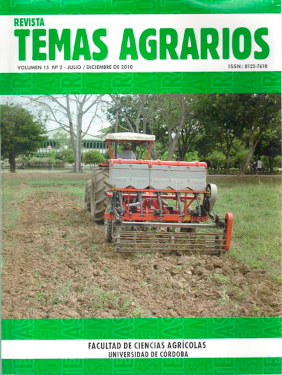Behavior of Nu Opal cotton variety in different spatial arrangements
Comportamiento de la variedad Nu OPAL (Gossypium hirsutum L.) bajo diferentes arreglos espaciales

This work is licensed under a Creative Commons Attribution-NonCommercial 4.0 International License.
Show authors biography
This research was carried out to determine the spatial arrangement with higher yield potential field of Nu Opal cotton variety under the agroecological conditions of the middle Sinu Valley. Were evaluated six different population densities from the variation of the distances among rows (from 1,0; 0,9; 0,8; 0,7; 0,6 to 0,5 m) and setting two plants per meter. These were compared with the density of population used by farmers in the producing area (62.500 plants ha-1). Treatments were arranged in a design of a randomized complete block (RCBD) with four replications. Planting was carried out in the experimental station Turipaná CORPOICA CI in the second half of 2006. The results showed that the spatial arrangements used did not affect neither the expression of plant height and flowering, nor the components of fiber quality. In contrast, significant differences (P<0,05) for the number of buttons and field performance were encountered. The highest yield of cotton-seed and fiber was shown for the control treatment to 5370,7 and 2028,3 kg ha-1 respectively. Notably, the treatment of 40,000 plants ha-1 had similar yields to the control with 5137,4 kg ha-1 of cotton-seed and 1986,7 kg ha-1 of fiber, having numerical but not statistical difference (P>< 0,05) for the number of buttons and field performance were encountered. The highest yield of cotton-seed and fiber was shown for the control treatment to 5370,7 and 2028,3 kg ha-1 respectively. Notably, the treatment of 40,000 plants ha-1 had similar yields to the control with 5137,4 kg ha-1 of cotton-seed and 1986,7 kg ha-1 of fiber, having numerical but not statistical difference (P>0,05) between them.
Article visits 1255 | PDF visits
Downloads
- Asociación de Biotecnología Vegetal Agrícola (Agro-Bio). 2010. Transgénicos en el mundo/ Región Andina/ Colombia. http://www.agrobio.org/fend/index.php?op= YXA9I2JXbDQmaW09I016UT0=
- Cadena, J. 2006. CORPOICA M-123: Nueva variedad de Algodón de fibra media con adaptación al Caribe Húmedo. http://www.turipana.org.co/Algodon.html [21 Junio 2009].
- Camargo, L y Arcón, L. 2007. Evaluación agronómica de diferentes densidades poblacionales en algodón (Gossypium hirsutum l.) variedad NuOpal bajo una distribución espacial organizada en el valle del sinú medio. Tesis Ingeniero Agrónomo. Universidad de Córdoba, Montería.
- CONALGODON. 2008. Desempeño del sector algodonero 2005 y perspectivas 2006. Confederación Colombiana de Algodón. http://www.conalgodon.com/portal/index.php [3 Julio 2009].
- DIAGONAL. 2000. La Clasificación del Algodón. Departamento de agricultura de los Estados Unidos EEUU (USDA), Estación Experimental Agropecuaria Sáenz Peña (INTA). http://www.inta.gov.ar/saenzpe/algodon/clasifalgodon.pdf [17 Julio 2009].
- FINAGRO. 2009. Sistema de información sectorial. Fondo para el financiamiento del sector agropecuario. http://www.finagro.com.co/html/cache/gallery/GC-8/G 11/arroz.pdf [17 Abril 2009]
- Fuentes, R. y Monterrosa, J. 2002. Respuesta agronómica de la variedad de algodón DP 5415 sembrado en tres densidades de población evaluados bajo condiciones del medio Sinú. Tesis IngenieroAgrónomo. Universidad de Córdoba, Montería.
- Gaytán-Mascorro, A., Palomo A., Reta D., Godoy S. y García E. 2004. Respuesta del algodón cv. Cian precoz al espaciamiento entre surcos y densidad poblacional. Revista Phyton 73(1):57-67.
- Guinn, G. 1982. Cause of square and boll shedding in cotton. Plant Physiol. 87: 629-631.Instituto Geográfico Agustín Codazzi (IGAC). 1996. Diccionario geográfico de Colombia. Tomo 3. Tercera edición, Bogotá, p1858.
- Jarma, A., Morales W. y Contreras A., 2002. Surcos ultra angostos en la nueva variedad de algodón corpoica M – 123 en el valle del Sinú. 2º Seminario Nacional algodonero. Memorias: 216, Corpoica, Cereté, p23 – 29.
- Jarma, A y Mendoza. 1999. Contribución del mejoramiento genético del algodonero y la productividad en el caribe Colombiano. VI Congreso Sociedad Colombiana de Fitomejoramiento y Producción de Cultivo, memorias: 64, Universidad de los Llanos, Villavicencio- Meta, p34 -39.
- Méndez-Natera, J. 2001. Efecto de dos densidades de población y dos niveles de fertilización sobre algunos caracteres vegetativos de tres cultivares de algodón (Gossypium hirsutum L.) en la sabana de Jusepín, Estado Monagas. Revista UDO agrícola 1(1):11-17
- Méndez-Natera, J. 2006. Efecto de la densidad de población y la fertilización sobre las características de los frutos de algodón (Gossypium hirsutum L.). Revista Idesia. 24(3):39-47.
- Palomo, G.; Gaytán, A. y Godoy, S. 1999. Respuesta de cuatro variedades de algodón (Gossypium hirsutum L.) a la densidad poblacional. Fitotecnia Mexicana 22(1):43-49.
- Rodríguez, N y Rodríguez, F. 1999. Comportamiento de dos genotipos comerciales de algodonero Gossypium hirsutum L. con tres densidades de población sembrados tardíamente en el Sinú medio. Tesis Ingeniero Agrónomo. Universidad de Córdoba, Montería p115.
- Rodríguez, L. 2000. Densidad de población vegetal y producción de materia seca. Bogotá: Revista Comalfi 27(1):12-15
- .




















